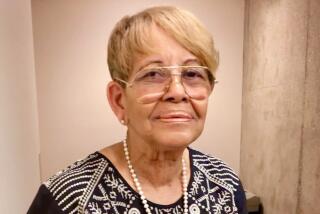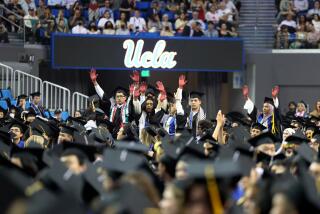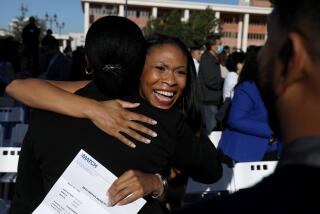Dressing for Success as Doctors
- Share via
In a moment both heady and fearsome, Judith Fleming took a few short steps across a stage at UC Irvine’s College of Medicine one recent evening--and one giant leap into the world of science. She shook hands with a raft of deans and then was ritually “cloaked” in the jacket she someday will wear as a physician.
The uninitiated might assume it was an age-old ritual--but so-called white coat ceremonies like this were unknown a decade ago. They have spread like a fever among the nation’s medical schools in the last five years: from 11 schools in 1995 to at least 125 of the nation’s 145 medical and osteopathic schools today.
As classes began this fall at schools ranging from UC medical colleges in Irvine, Los Angeles and San Diego to private schools at the University of Chicago, Columbia and Stanford, more than 15,000 new medical students are being garbed and sworn to the ethics of their profession at ceremonies attended by hundreds of family, friends and faculty.
The new rite of passage, in which entering students are cloaked in the white jackets favored by physicians, comes complete with the age-old admonition of Hippocrates to, above all, do no harm--a step previously reserved for graduation. The ceremonies are designed to arm students for the complexities of 21st century practice, focusing prospective physicians on caring and ethics from their first day of training.
As part of the event, students recite a version of that 2,500-year-old Greek oath, although most commonly the pledge is a modern update written by the school’s professors or recent graduates.
At UC Irvine, 93 students in the entering class recited a graduation oath written by UC Irvine’s class of 1977, pledging to “practice medicine for people rather than things.”
The movement to focus intently on humanism in medicine comes as medical faculty, scholars and others worry that today’s physicians will confront technological advances and economic pressures that will wage ever more complex assaults on their professional values and interpersonal skills.
The movement toward managed care, for example, is forcing many doctors to balance the needs of patients against their own business concerns.
And ironically, it was at UC Irvine that physicians in the fertility clinic, on the cutting edge of new medical technology, were accused of violating patient rights in 1995.
“There is no question that individuals practicing in the present environment are being ethically challenged far more than in the past,” said Dr. Albert Manetta, senior associate dean for educational affairs at UC Irvine’s College of Medicine.
“Our only mission when I began practice was to do the best you could for the patient without regard for any financial consequences. They gave you a ballpoint pen and a prescription pad and if you had ink, you could prescribe. Today, you have to align with institutional goals and that can create conflicts.”
The Journal of the American Medical Assn. reported in September that 90% of schools offer some kind of training in professionalism, and just over half have some means of evaluating students’ professional behavior.
Nevertheless, the new tradition of white coat ceremonies has its critics.
The UC Davis School of Medicine calls the goal laudable but says the event is not worth the hassle or cost.
“I am not sure what this adds,” said Dr. Ernest Lewis, associate dean for medical education, adding that at Davis they prefer to teach ethics and humanism by example and spend the time picking students “with strong humanitarian skills and leanings.”
“Reciting marriage vows do not ensure a perfect marriage or even a faithful one,” Lewis said.
The ritual got started at the University of Chicago in 1989 after a professor complained to Dean of Students Norma F. Wagoner that first-year students were “showing up in shorts and baseball caps” for sessions “where the patients are pouring their hearts out.”
Wagoner decided the fix was to create a ceremonial program in which students were given physician coats. The school invited parents and told the students that “for any session where we have patients present, we expect you to look like professionals, wear the white coat and behave appropriately,” she said.
The idea was batted around for a few years before Dr. Linda Lewis, dean at Columbia University College of Physicians and Surgeons, joined with the Arnold P. Gold Foundation to sponsor the first full-fledged white coat ceremony.
It was held at Columbia in 1993, with the entering class reciting a modern version of the Hippocratic Oath. Formerly, that pledge had been taken only at graduation.
Gold, a professor at Columbia, said rearranging that oath’s timing actually returns to the original concept of Hippocrates, who had students recite it at the outset of their apprenticeship.
“It was a condition of training,” Gold said. “Instead, we had them taking an oath about the kind of doctor they would become at graduation. It was four years too late.”
The Gold Foundation, which is dedicated to humanism in medicine, helps sponsor the ceremonies at more than 100 schools, providing grants and other assistance.
Nationwide, the ceremonies are treated like mini-graduations, complete with invitations, and often followed by a buffet reception with deans and faculty.
At UC Irvine last month, nearly 500 people packed the Emerald Bay Room at the student center as each first-year student crossed the stage, was introduced by name, shook hands with professors and deans, then was assisted into a starched white coat.
Coat Is Symbol of ‘Mutual Respect’
Scores of doting parents rushed forward and snapped photographs while the occasional married spouse cuddled a sleeping infant.
UCLA had its fourth coat ceremony last month, with students reciting an oath written by senior faculty. Dr. Alan Robinson, vice provost, medical sciences and executive dean, school of medicine, told the audience that the white coat is a symbol of “the mutual respect” that patient and physician must share.
He reminded the 177 students that despite managed care and advances in technology, they should “not forget the inner person. . . . Physicians should care as well as cure.”
Longtime faculty members find the event stirring, especially so because it binds students to a creed that dates from ancient Greece.
“When I hear the oath I get chills,” said Dr. Michael Prislin, professor of family medicine and UC Irvine associate dean for student affairs. “No matter what happens in the advance of biotechnology, it is caring for other people that is timeless. There is a value to holding someone’s hand. There is a reemergence of the themes of humanism.”
Deans readily concede they can’t prove the ritual works, but they tell stories of student enthusiasm.
Fleming of Los Angeles, the incoming UC Irvine student, described the event as a comfort. After 13 years working as a veterinary nurse, she is humbled by the prospect of becoming a doctor, especially the “fear that I could do harm in this profession,” she said.
“I want to be among people who are as gracious and compassionate and honest as possible,” she said after the ceremony, adding: “My main concern is that my classmates would be irresponsible children who I couldn’t trust with anything. I am very pleased to see the learning process includes this.”
Several deans said an affirmation of humanism is needed now more than ever. For one thing, training is more rushed. Patient stays in hospitals are shorter and students’ time with them briefer.
“Today, a patient is admitted and goes home the next day,” said Columbia’s Lewis. “People in the hospital are so much sicker. The wonderful luxury of taking time with patients is no longer there and students are rushed and pushed.”
A Memorable Spontaneous Moment
In the few years the ritual has been performed, one moment has become emblematic. Through an oversight, administrators at Columbia in 1995 had failed to provide a coat for one student.
When Dr. Daphne Stewart, today a resident at UCLA, walked to the stage, the deans were at a loss. They shook her hand, shrugged their shoulders and sent Stewart back to her seat. Coatless.
In a moment that has become legend, Lewis spontaneously called Stewart back to the stage, took off her own coat and put it on Stewart.
The audience rose to applaud.
“I think it is so important to have these students be part of the profession and realize it is a giving, caring society,” said Lewis, recalling the dual symbolism.
“It seemed to be the right thing to do at the time.”
More to Read
Sign up for Essential California
The most important California stories and recommendations in your inbox every morning.
You may occasionally receive promotional content from the Los Angeles Times.










